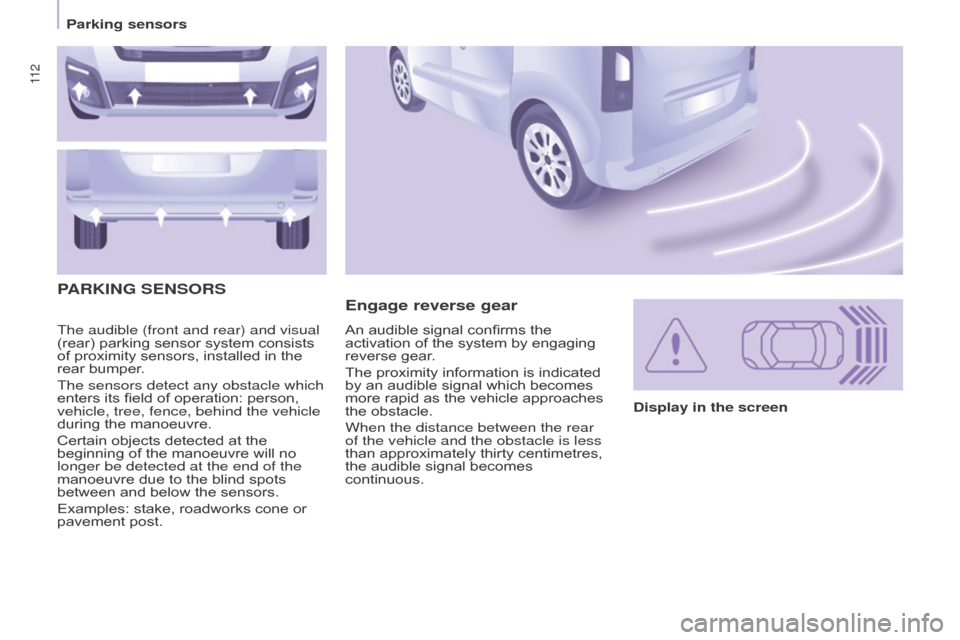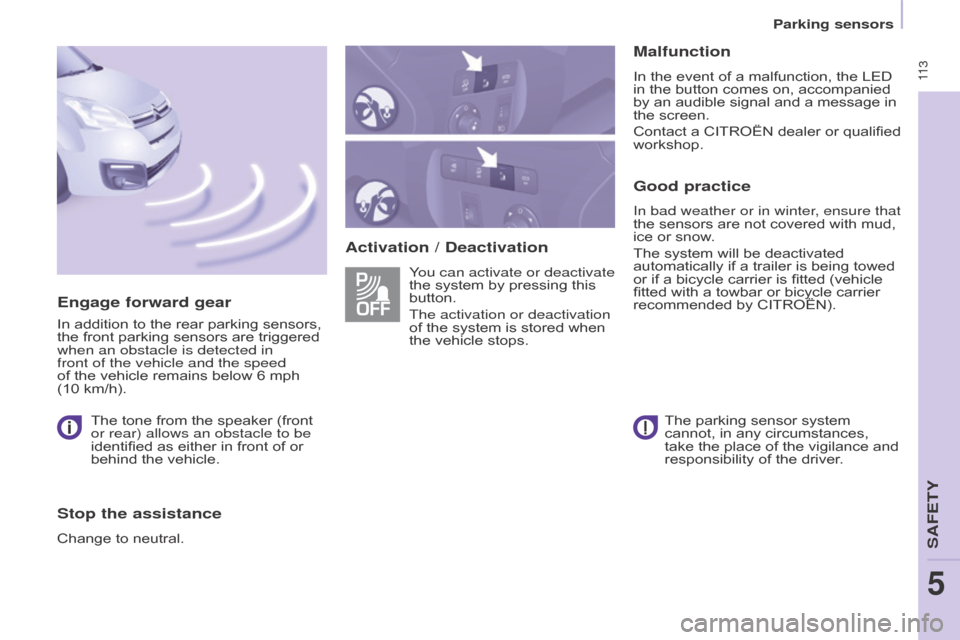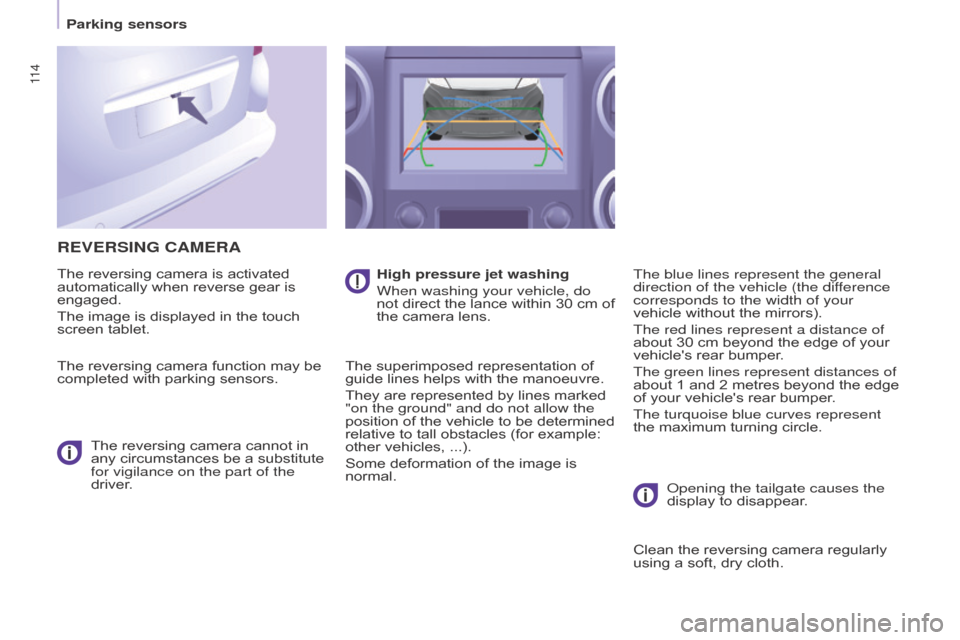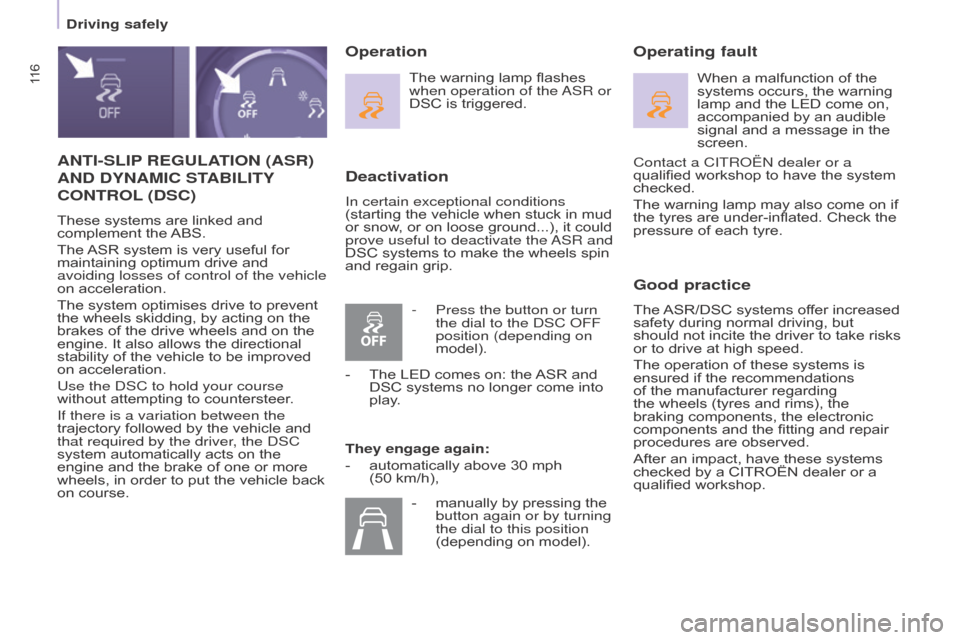Citroen BERLINGO MULTISPACE 2015 2.G Owner's Manual
Manufacturer: CITROEN, Model Year: 2015, Model line: BERLINGO MULTISPACE, Model: Citroen BERLINGO MULTISPACE 2015 2.GPages: 298, PDF Size: 12.69 MB
Page 111 of 298

109
Berlingo-2-VP_en_Chap04_Ergonomie_ed01-2015Berlingo-2-VP_en_Chap04_Ergonomie_ed01-2015
SURVEILLANCE MIRROR
This mirror, placed on top of the central mirror, enables the driver or
front passenger to observe all the rear
seats.
Fitted
on its own ball joint, it's manual
adjustment
is simple and provides a
view
of the rear interior of the vehicle.
It
can also be adjusted for improved
visibility
during manoeuvres or when
overtaking.
REAR WINDOWS
To partially open the rear windows, tilt
the lever and push it fully to lock the
windows
in the open position.
Manual rear view mirror
The rear view mirror has two positions:
-
day
(normal),
-
night
(anti-dazzle).
To
change from one to the other, push
or pull the lever on the lower edge of
the
mirror.
EASE OF USE and COMFORT
4
Mirrors and windows
Page 112 of 298

11 0
Berlingo-2-VP_en_Chap04_Ergonomie_ed01-2015Berlingo-2-VP_en_Chap04_Ergonomie_ed01-2015
ELECTRIC WINDOWS
Lower the window fully, then raise it, it
will rise in steps of a few centimetres
each
time the control is pressed.
Repeat the operation until the window
is
fully closed.
Continue to press the control for at
least one second after the window
closed
position has been reached.
The safety anti-pinch does not operate
during
these operations.
Safety anti-pinch
When the window rises and meets an obstacle, it stops and partially lowers.
Manual mode
This mode is available depending on equipment; it is
identified
by this symbol on the
control
in question.
Good practice
If the electric windows meet an obstacle during operation, you must
reverse
the movement of the window.
T
o
do
this,
press
the
control
concerned.
When the driver operates the
passenger electric window controls,
they
must ensure that no one is
preventing correct closing of the
windows.
The
driver must ensure that the
passengers use the electric windows
correctly
.
Be aware of children when operating
the
windows.
Following
several consecutive closing/
opening operations of the electric
window
control, a protection system
is triggered which only allows closing
of
the window.
After
closing, wait
approximately
40 minutes. Once this
time
has elapsed, the control becomes
operational
again.
1.
d
river's side
2.
Passenger's side
Reinitialisation
Following reconnection of the battery,
or in the event of a malfunction, the
safety
anti-pinch function must be
reinitialised. The electrical functions of the electric
windows
are deactivated:
-
approximately
45 seconds after the
ignition is switched of
f,
-
after one of the front doors is
opened,
if the ignition is off.
There
are
two
operating
modes:
Press or pull the control, without
passing
the
point
of
resistance.
The window stops when you release
the
control.
One-touch mode
Press or pull the control, beyond the
point
of resistance.
The window opens or closes fully when
the
control is released.
Pressing or pulling the control again
stops
the movement of the window.
Mirrors and windows
Page 113 of 298

111
Berlingo-2-VP_en_Chap05_Securite_ed01-2015
HAZARD WARNING LAMPS
H
ORN
Press the centre of the steering wheel.
PARKING BRAKE
Applying
Pull the parking brake lever up to immobilise
your vehicle.
Check
that the parking brake is applied
firmly
before leaving the vehicle.Pull
on the parking brake lever, only
with the vehicle stationary.
In the exceptional case of use of the
parking
brake when the vehicle is
moving,
apply the brake by pulling
gently
to avoid locking the rear wheels
(risk
of skidding).
Press this button, the direction
indicators
flash.
They
can
operate
with
the
ignition
off.
The
hazard
warning
lamps
should
only
be used in dangerous situations, when
stopping
in
an
emergency
or
when
driving
in
unusual
conditions.
When
parking on a slope, direct your
wheels
towards the pavement and pull
the
parking brake lever up.
There is no advantage in engaging
a
gear after parking the vehicle,
particularly
if the vehicle is loaded.
If the parking brake is still on or has not been released properly, this is
indicated
by this warning lamp which
comes
on on the instrument panel.
Automatic operation of hazard
warning lamps
When braking in an emergency, depending on the force of deceleration,
the hazard warning lamps come
on
automatically.
They
switch off
automatically
the first time you
accelerate.
It
is also possible to switch them off by
pressing
the switch on the dashboard.Releasing
Pull the lever up slightly and press the
button to lower the parking brake lever.
driving safely
SaFETY
5
Page 114 of 298

11 2
Berlingo-2-VP_en_Chap05_Securite_ed01-2015
The audible (front and rear) and visual
(rear) parking sensor system consists
of
proximity sensors, installed in the
rear
bumper.
The sensors detect any obstacle which
enters
its field of operation: person,
vehicle, tree, fence, behind the vehicle
during
the manoeuvre.
Certain
objects detected at the
beginning
of the manoeuvre will no
longer be detected at the end of the
manoeuvre
due to the blind spots
between
and below the sensors.
Examples:
stake, roadworks cone or
pavement
post.
Engage reverse gear
P
ARKING
SENSORS
Display in the screen
An
audible
signal
confirms
the
activation
of
the
system
by
engaging
reverse
gear.
The
proximity
information
is
indicated
by
an
audible
signal
which
becomes
more
rapid
as
the
vehicle
approaches
the
obstacle.
When the distance between the rear
of the vehicle and the obstacle is less
than
approximately
thirty
centimetres,
the
audible
signal
becomes
continuous.
Parking sensors
Page 115 of 298

11 3
Berlingo-2-VP_en_Chap05_Securite_ed01-2015
Activation / DeactivationMalfunction
In the event of a malfunction, the LED in
the button comes on, accompanied
by
an audible signal and a message in
the
screen.
Contact
a CITROËN dealer or qualified
workshop.
Good practice
In bad weather or in winter, ensure that
the sensors are not covered with mud,
ice
or snow.
The
system will be deactivated
automatically
if a trailer is being towed
or
if a bicycle carrier is fitted (vehicle
fitted
with a towbar or bicycle carrier
recommended
by CITROËN).
You can activate or deactivate
the
system
by
pressing
this
button.
The activation or deactivation
of
the
system
is
stored
when
the
vehicle
stops.
Engage forward gear
In addition to the rear parking sensors, the front parking sensors are triggered
when an obstacle is detected in
front of the vehicle and the speed
of
the vehicle remains below 6 mph
(10 km/h).The
tone from the speaker (front
or rear) allows an obstacle to be
identified
as either in front of or
behind
the vehicle.
Stop the assistance
Change to neutral. The parking sensor system
cannot,
in any circumstances,
take
the place of the vigilance and
responsibility
of the driver.
Parking sensors
SaFETY
5
Page 116 of 298

11 4
Berlingo-2-VP_en_Chap05_Securite_ed01-2015
REVERSING CAMERA
The reversing camera is activated automatically when reverse gear is
engaged.
The
image is displayed in the touch
screen
tablet.
The
reversing camera function may be
completed
with parking sensors.
The
reversing camera cannot in
any
circumstances be a substitute
for vigilance on the part of the
driver
. High pressure jet washing
When washing your vehicle, do
not
direct
the
lance
within
30
cm
of
the
camera lens.
The
superimposed representation of
guide
lines helps with the manoeuvre.
They
are represented by lines marked
"on the ground" and do not allow the
position
of the vehicle to be determined
relative
to tall obstacles (for example:
other
vehicles, ...).
Some
deformation of the image is
normal.The blue lines represent the general
direction of the vehicle (the dif
ference
corresponds to the width of your
vehicle
without the mirrors).
The red lines represent a distance of
about
30 cm beyond the edge of your
vehicle's
rear bumper.
The green lines represent distances of
about
1 and 2 metres beyond the edge
of
your vehicle's rear bumper.
The turquoise blue curves represent
the
maximum turning circle.
o
pening the tailgate causes the
display
to disappear.
Clean
the reversing camera regularly
using
a soft, dry cloth.
Parking sensors
Page 117 of 298

ABS
ABS
11 5
Berlingo-2-VP_en_Chap05_Securite_ed01-2015
ANTI-LOCK BRAKING SYSTEM
(ABS / EBFD)
The ABS and EBFD (electronic brake force
distribution) systems improve the
stability
and manoeuvrability of your
vehicle
on braking, in particular on
poor
or slippery surfaces.
The
ABS
prevents locking of the
wheels, the EBF
d provides control of
the
braking pressure wheel by wheel.If
this warning lamp comes on,
accompanied by an
audible
signal and a message
in the screen, it indicates a
malfunction
of the
ABS
which
could result in a loss of control of the
vehicle
on braking.
If
this warning lamp comes
on,
together with the brake
and
STOP
warning lamps,
accompanied
by an audible
signal
and a message in the
screen,
it indicates a malfunction of
the
electronic brake force distribution
which could result in a loss of control of
the
vehicle on braking.
EMERGENCY BRAKING
ASSIST
ANCE (EBA)
In an emergency, this system enables the optimum braking pressure to be
reached
more quickly, press the pedal
firmly
without releasing it.
It is triggered by the speed at which the
brake
pedal is pressed down.
This
alters the resistance of the brake
pedal
under your foot.
To
maintain operation of the
emergency
braking assistance system:
keep
your foot on the brake pedal.
Good practice
The anti-lock braking system comes into operation automatically when
there
is a risk of wheel lock. It does not
reduce
the braking distance.
o
n very slippery surfaces (ice,
oil, etc...)
the
ABS
may increase the
braking
distance. When braking in
an
emergency, do not hesitate to
press
the brake pedal firmly, without
releasing the pressure, even on a
slippery surface, you will then be able
to
continue to manoeuvre the vehicle
to
avoid an obstacle.
Normal
operation of the
ABS
may be
felt
by slight vibration of the brake
pedal.
When changing wheels (tyres and
rims),
ensure that these are listed by
CITROËN
for the vehicle. Stop as soon as it is safe to do so.
In both cases, contact a CITR
o Ë n
dealer
or a qualified workshop.
driving safely
SaFETY
5
Page 118 of 298

11 6
Berlingo-2-VP_en_Chap05_Securite_ed01-2015
ANTI-SLIP REGULATION (ASR)
AND
DYNAMIC STABILITY
CONTROL (DSC)
These systems are linked and complement the ABS.
The
ASR
system is very useful for
maintaining
optimum drive and
avoiding losses of control of the vehicle
on
acceleration.
The
system optimises drive to prevent
the
wheels skidding, by acting on the
brakes
of the drive wheels and on the
engine.
It also allows the directional
stability
of the vehicle to be improved
on
acceleration.
Use the
d SC to hold your course
without
attempting to countersteer.
If there is a variation between the
trajectory
followed by the vehicle and
that required by the driver
, the d SC
system
automatically acts on the
engine
and the brake of one or more
wheels,
in order to put the vehicle back
on
course.
Deactivation
In certain exceptional conditions
(starting the vehicle when stuck in mud
or
snow, or on loose ground...), it could
prove useful to deactivate the a
SR and
DSC
systems to make the wheels spin
and
regain grip.
Operating fault
Good practice
The ASR/DSC systems offer increased safety
during normal driving, but
should
not incite the driver to take risks
or
to drive at high speed.
The
operation of these systems is
ensured
if the recommendations
of
the manufacturer regarding
the
wheels (tyres and rims), the
braking
components, the electronic
components
and the fitting and repair
procedures
are observed.
After
an impact, have these systems
checked
by a CITROËN dealer or a
qualified
workshop.
Operation
The warning lamp flashes when operation of the a SR or
DSC
is triggered.
They engage again:
-
automatically
above 30 mph
(50
km/h), When
a malfunction of the systems
occurs, the warning
lamp
and the LED come on,
accompanied
by an audible
signal
and a message in the
screen.
-
Press the button or turn
the dial to the
d SC o FF
position (depending on
model).
-
The
LED comes on: the
ASR
and
DSC
systems no longer come into
play
. -
manually
by pressing the
button again or by turning
the dial to this position
(depending
on model).Contact a CITR
o Ë n dealer or a
qualified
workshop to have the system
checked.
The
warning lamp may also come on if
the
tyres are under-inflated. Check the
pressure
of each tyre.
driving safely
Page 119 of 298

117
Berlingo-2-VP_en_Chap05_Securite_ed01-2015
GRIP CONTROL
Correct use
Your vehicle is designed principally to
drive
on tarmac roads but it allows you
to drive on other less passable terrain
occasionally
.
However, particularly when your
vehicle is heavily laden, it does not
permit
off-road activities such as:
-
crossing and driving on ground
which
could damage the underbody
or
tear off components (fuel pipe,
fuel
cooler, ...), particularly by
obstacles or stones,
-
driving on ground with steep
gradients and poor grip,
-
crossing
a stream.
On
snow,
mud
or
sand,
traction
control
is
obtained
by
a
compromise
between
safety
, grip, traction and appropriate
tyres.
It
adapts
to
allows
most
conditions
of
poor
grip
to
be
accommodated.
The
accelerator
pedal
must
be
pressed
enough for there to be adequate
engine
power
to
manage
the
various
parameters
in
the
best
way.
driving safely
SaFETY
5
Page 120 of 298

11 8
Berlingo-2-VP_en_Chap05_Securite_ed01-2015
different modes are available:
Normal (ESC)
ESC OFFSnow
This mode allows the vehicle to adapts its strategy to the
conditions of grip encountered
for each of the two front
wheels,
on moving off.
When
moving, the system optimises
wheelspin to provide the best
acceleration possible for the grip
available.
Off road
(mud, wet grass, ...)
When moving off, this mode allows considerable
wheelspin on the wheel
with the least grip to favour
clearing
of the mud and
regain
"grip".
At
the
same time, the wheel with the
most
grip
is controlled in such a way as
to
transmit as much torque as possible.
When
moving, the system optimises
wheelspin
to meet the driver's
requirements
as fully as possible.
Sand
This mode allows a little wheelspin on the two driving
wheels at the same time to
allow
the vehicle to move
forward
and reduces the risk
of
getting stuck in the sand.
Do
not
use the other modes on sand
as
the
vehicle may become stuck.
This
mode
is
calibrated
for
a
low
level
of
skidding,
based
on dif
ferent conditions of grip
encountered
on
the
road.
When the ignition is switched off, the
system
returns
automatically
to
DSC
mode.
This
mode
is
only
suitable
for
specific
conditions
encountered
when
moving
off
or
at
low
speed.
Above
30
mph
(50
km/h)
the
system
returns
to
DSC
mode
automatically
.
driving safely